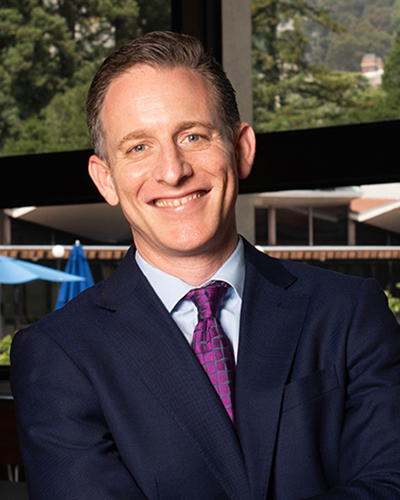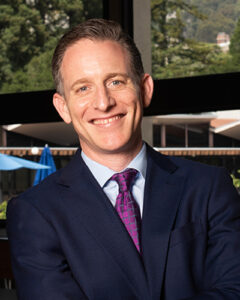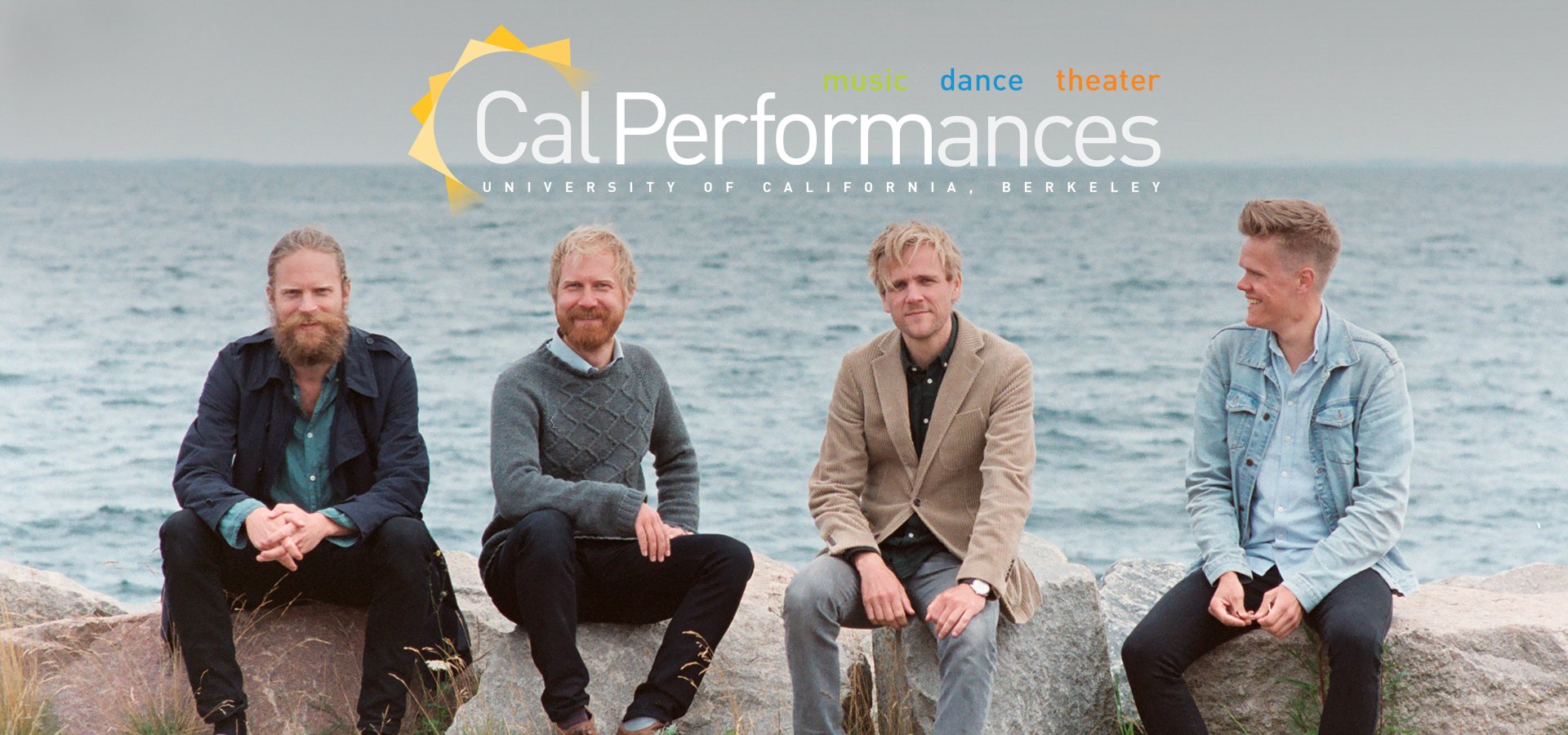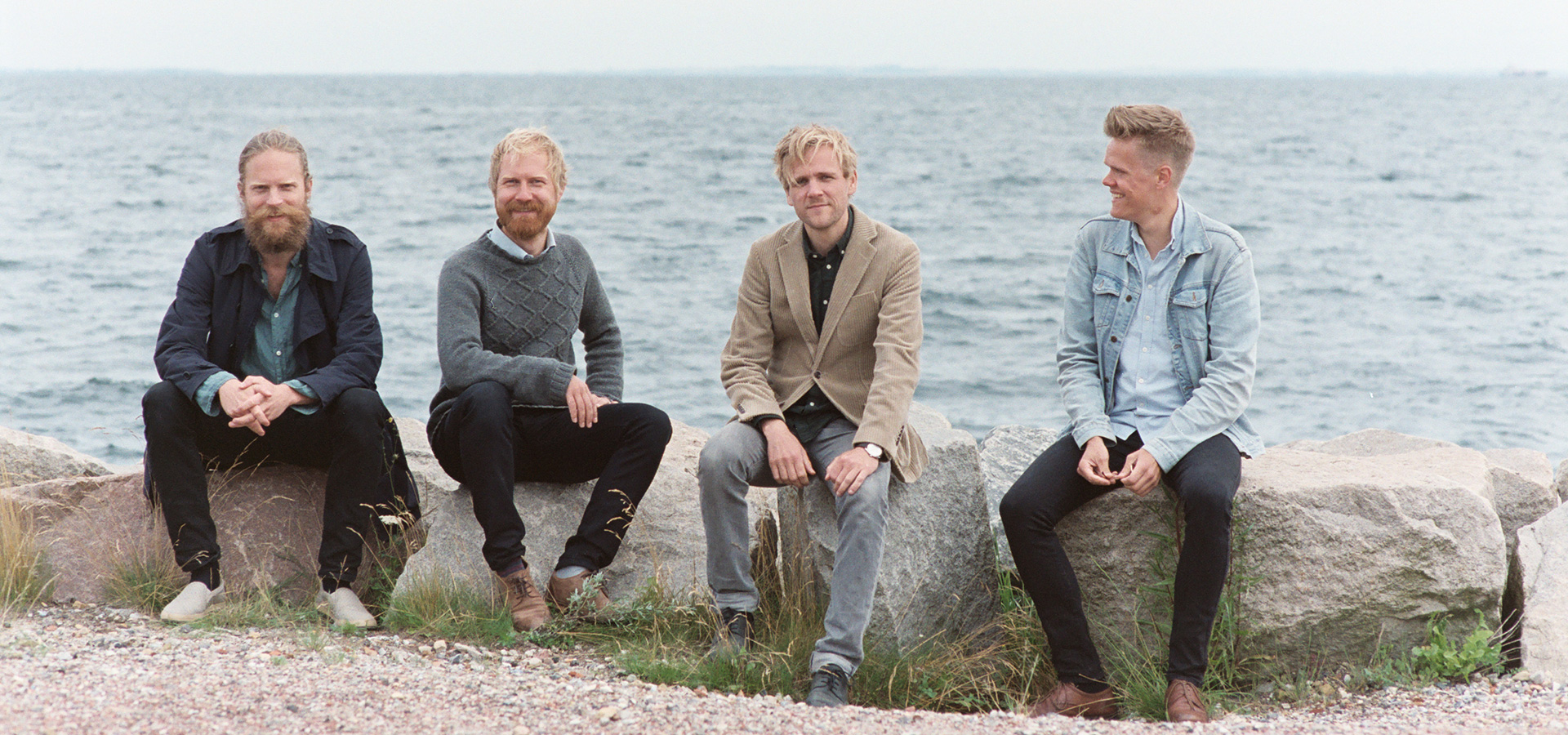Danish String Quartet
Johannes Rostamo, cello
Saturday, April 13, 2024, 8pm
Zellerbach Hall, Berkeley
Major support for this performance is provided by The Bernard Osher Foundation. This performance is made possible, in part, by Diana Cohen and Bill Falik.
Cal Performances is committed to fostering a welcoming, inclusive, and safe environment for all—one that honors our venues as places of respite, openness, and respect. Please see the Community Agreements section on our Policies page for more information.
From the Executive and Artistic Director

As we enter the final weeks in Cal Performances’ 2023–24 season, it’s natural to take a look back and remember the highlights of a truly remarkable eight months at UC Berkeley. We will all have our favorite moments—instances when a performance seemed to leap off the stage and speak to us directly. But if such experiences are deeply personal, they also all depend on the communal act of gathering together and opening our eyes, ears, and hearts to the miracle of artistic expression. Every day throughout the world, people come to performances to celebrate what it means to be human in an increasingly impersonal world. As this particular season winds down, let me thank each and every one of you for taking part in the magic of great—and live!—music, theater, and dance.
Once again, April means one thing in particular at Cal Performances—Ailey Week—when the renowned Alvin Ailey American Dance Theater returns for its annual spring residency. With its relationship with UC Berkeley now in its 56th year (Ailey has visited campus every non-pandemic year since 1968), the company will present five separate programs from April 2 through April 7. The centerpiece of this year’s residency is the 2024 Gala on Thursday, April 4, with all proceeds benefiting Cal Performances’ artistic initiatives and education programs. During the week, we will also present an Ailey SchoolTime performance for K–12 students and provide an opportunity for alumni of Berkeley/Oakland AileyCamp to reconnect with company members. On opening night, Tuesday, April 2, I’m especially proud that Cal Performances will offer live audio descriptions and a pre-performance haptic tour for blind and visually impaired audience members.
As the season draws to a close in early May, we still have much to look forward to: gifted early-music artists like countertenor Jakub Józef Orliński with the acclaimed ensemble Il Pomo d’Oro (Apr 9) and Jordi Savall with Hespèrion XXI (Apr 12); the thunderous traditional taiko drumming of Drum Tao (Apr 11–12); superb chamber music with the Danish String Quartet and guest cellist Johannes Rostamo (Apr 13) and French ensemble Quatuor Ébène (Apr 16); a duo vocal recital with opera stars (and a husband-and-wife team to boot!) soprano Amina Edris and tenor Pene Pati, with Robert Mollicone at the piano (Apr 23); a highly anticipated return to campus by one of the most adventurous artists on the international pop music scene, the always astonishing Angélique Kidjo (Apr 26); astounding Icelandic pianist Víkingur Ólafsson in a special performance of J.S. Bach’s immortal Goldberg Variations (May 4); and an evening with America’s preeminent humor writer—and frequent guest of Cal Performances—David Sedaris (May 5).
And I must make special mention of the upcoming visit by our dear friends at the Mark Morris Dance Group (Apr 19–21), returning to their West Coast home away from home with a profoundly moving repertory work (2010’s Socrates) and the world premiere of a new Mark Morris creation, Via Dolorosa, set to Nico Muhly’s meditative composition The Street (performed live by harpist Parker Ramsay). In the more than 35 years since the company first appeared at UC Berkeley, Mark Morris’ dancers have treated Cal Performances audiences to the premieres of more than a dozen new Morris works, many of which have gone on to become company classics—don’t miss this chance to be part of dance history!
Finally, I hope you’ll join us on April 16, when we announce our extraordinary 2024–25 season. One major detail has already been announced—the Maria Manetti Shrem and Elizabeth Segerstrom California Orchestra Residency, when Cal Performances and the Philharmonic Society of Orange County will bring the world renowned Vienna Philharmonic and conductor Yannick Nézet-Séguin to California during spring 2025. And I can promise you many more welcome and exciting surprises when full season details are announced.
Again, thank you for joining us this season. I look forward to seeing you again in the fall.
Jeremy Geffen
Executive and Artistic Director, Cal Performances
 As we enter the final weeks in Cal Performances’ 2023–24 season, it’s natural to take a look back and remember the highlights of a truly remarkable eight months at UC Berkeley. We will all have our favorite moments—instances when a performance seemed to leap off the stage and speak to us directly. But if such experiences are deeply personal, they also all depend on the communal act of gathering together and opening our eyes, ears, and hearts to the miracle of artistic expression. Every day throughout the world, people come to performances to celebrate what it means to be human in an increasingly impersonal world. As this particular season winds down, let me thank each and every one of you for taking part in the magic of great—and live!—music, theater, and dance.
As we enter the final weeks in Cal Performances’ 2023–24 season, it’s natural to take a look back and remember the highlights of a truly remarkable eight months at UC Berkeley. We will all have our favorite moments—instances when a performance seemed to leap off the stage and speak to us directly. But if such experiences are deeply personal, they also all depend on the communal act of gathering together and opening our eyes, ears, and hearts to the miracle of artistic expression. Every day throughout the world, people come to performances to celebrate what it means to be human in an increasingly impersonal world. As this particular season winds down, let me thank each and every one of you for taking part in the magic of great—and live!—music, theater, and dance.
Once again, April means one thing in particular at Cal Performances—Ailey Week—when the renowned Alvin Ailey American Dance Theater returns for its annual spring residency. With its relationship with UC Berkeley now in its 56th year (Ailey has visited campus every non-pandemic year since 1968), the company will present five separate programs from April 2 through April 7. The centerpiece of this year’s residency is the 2024 Gala on Thursday, April 4, with all proceeds benefiting Cal Performances’ artistic initiatives and education programs. During the week, we will also present an Ailey SchoolTime performance for K–12 students and provide an opportunity for alumni of Berkeley/Oakland AileyCamp to reconnect with company members. On opening night, Tuesday, April 2, I’m especially proud that Cal Performances will offer live audio descriptions and a pre-performance haptic tour for blind and visually impaired audience members.
As the season draws to a close in early May, we still have much to look forward to: gifted early-music artists like countertenor Jakub Józef Orliński with the acclaimed ensemble Il Pomo d’Oro (Apr 9) and Jordi Savall with Hespèrion XXI (Apr 12); the thunderous traditional taiko drumming of Drum Tao (Apr 11–12); superb chamber music with the Danish String Quartet and guest cellist Johannes Rostamo (Apr 13) and French ensemble Quatuor Ébène (Apr 16); a duo vocal recital with opera stars (and a husband-and-wife team to boot!) soprano Amina Edris and tenor Pene Pati, with Robert Mollicone at the piano (Apr 23); a highly anticipated return to campus by one of the most adventurous artists on the international pop music scene, the always astonishing Angélique Kidjo (Apr 26); astounding Icelandic pianist Víkingur Ólafsson in a special performance of J.S. Bach’s immortal Goldberg Variations (May 4); and an evening with America’s preeminent humor writer—and frequent guest of Cal Performances—David Sedaris (May 5).
And I must make special mention of the upcoming visit by our dear friends at the Mark Morris Dance Group (Apr 19–21), returning to their West Coast home away from home with a profoundly moving repertory work (2010’s Socrates) and the world premiere of a new Mark Morris creation, Via Dolorosa, set to Nico Muhly’s meditative composition The Street (performed live by harpist Parker Ramsay). In the more than 35 years since the company first appeared at UC Berkeley, Mark Morris’ dancers have treated Cal Performances audiences to the premieres of more than a dozen new Morris works, many of which have gone on to become company classics—don’t miss this chance to be part of dance history!
Finally, I hope you’ll join us on April 16, when we announce our extraordinary 2024–25 season. One major detail has already been announced—the Maria Manetti Shrem and Elizabeth Segerstrom California Orchestra Residency, when Cal Performances and the Philharmonic Society of Orange County will bring the world renowned Vienna Philharmonic and conductor Yannick Nézet-Séguin to California during spring 2025. And I can promise you many more welcome and exciting surprises when full season details are announced.
Again, thank you for joining us this season. I look forward to seeing you again in the fall.
Jeremy Geffen
Executive and Artistic Director, Cal Performances
About the Program
Doppelgänger Project Part IV:
Schubert and Adès
With this performance, the Danish String Quartet (DSQ) completes the epic, internationally touring Doppelgänger Project that it first brought to Cal Performances in the fall of 2021. (See p. 15b for an overview.)
Juxtaposing four newly commissioned works with chamber music milestones by Franz Schubert, the DSQ’s journey began with a pairing of the String Quartet in G major (D. 887) with Danish composer Bent Sørensen’s Doppelgänger Quartet; proceeded with Finnish composer Lotta Wennäkoski’s Pige as a contemporary commentary on and deconstruction of its Schubertian companion, Death and the Maiden (String Quartet in D minor, D. 810); and continued last season with Anna Thorvaldsdottir’s Rituals, which shared the bill with the String Quartet in A minor, D. 804 (Rosamunde).
This evening’s culminating program involves a shift in genre from string quartet to string quintet. Curiously, it coincides with the geographical shift from commissioned composers who hail from Scandinavian countries to the London-born Thomas Adès. After the DSQ broached the idea of the commission with Adès, the ensemble’s violist Asbjørn Nørgaard recalls, the composer expressed a preference to respond to Schubert’s String Quintet in C major, D. 956, rather than to one of his string quartets. In particular, the unique sound of the two cellos that gives the quintet its sonic signature awakened Adès’ curiosity.
The result is the latest creation from one of the world’s most-sought-after composers: Wreath—for Franz Schubert. “I am most grateful to the great Danish String Quartet for giving me the time and encouragement to realize and develop this new path in my work,” Adès writes in the freshly completed score.
Schubert’s C major Quintet from 1828 is the last, chronologically, of the four chamber music works by the short-lived Austrian composer chosen for the Doppelgänger commissions. Performing this widely ranging score “always feels a bit like a special event,” says Nørgaard—not least because of the need to invite a guest artist who can adapt to the intricate chemistry developed over years by the regular ensemble. The Royal Stockholm Philharmonic Orchestra’s principal cellist Johannes Rostamo, who does the honors, was an obvious choice, since he has long been good friends with the DSQ and even studied in the same class in Stockholm with the group’s cellist, Fredrik Schøyen Sjölin (as a Norwegian, the DSQ’s sole non-Dane).
“He’s such a good fit for us, because he has the same ideas of how you rehearse and create sound, how you act around other people,” says Nørgaard. He jokingly adds that the two cellists even share an eerie resemblance—another instance of the inescapable Doppelgänger phenomenon.
As a coda to the program and the Doppelgänger journey, the members of the DSQ continue their practice of presenting the ensemble’s own arrangement for string quartet of a Schubert Lied that has a special relevance. “Die Nebensonnen” from the song cycle Winterreise, manifests yet another example of Schubert’s command of the uncanny—the frisson of recognition that lies at the heart of any Doppelgänger encounter.
“It’s All There”:
Schubert’s Epic String Quintet
The late-period Quintet in C major looms large not only within Schubert’s creative career but within the chamber music literature overall. The work dates from his final summer—part of an astonishing creative outpouring that included the final trilogy of piano sonatas and the song cycle Schwanengesang (Swan Song). Indeed, it is sometimes difficult to resist “swan song” associations with this music, although Schubert, who had been suffering for years from the effects of syphilis, could not have predicted the sudden decline in health that precipitated his death in November 1828.
The Quintet draws together the finest aspects of Schubert’s musical explorations from his last years: the expansive, epic scope of the Great C major Symphony and the final piano sonatas, the reassuring intimacy of music-making among friends, and the eagerness to experiment with harmonic horizons and ambiguities—tendencies that anticipate priorities for the Romantic era.
“It really does stand apart from the rest of the literature,” according to Asbjørn Nørgaard. “It’s all there. The String Quintet is full of everything, from the simplest, most banal gestures to the biggest statements of humanity and life. And it’s all nonverbal, so everybody can find their own space inside of this piece.”
Like so many of Schubert’s masterpieces, the Quintet remained unknown for decades after the composer’s death in 1828. It was not premiered until 1850 and then published in 1853. Unlike his beloved Mozart’s default choice for string quintet scoring, which was to add a second viola, Schubert opted for an extra cello and the corresponding textural expansion of the low range. While Luigi Boccherini had pioneered the two-cello quintet, Schubert gives all five voices “virtually equal prominence,” as the musicologist Robert Winter observes.
The opening music only sounds like a slow introduction but is already part of the vast first movement. From the uneasy stasis of this beginning, Schubert generates a fascinating tension. The dramatic first theme is followed by a second theme of radiant loveliness introduced by the two duetting cellos—the unique “doubling” that captivated Adès and inspired his impulse to write a string quintet.
The ambitiously proportioned first movement covers a wide emotional range, alternating between passages of desperate urgency and unhurried leisure. Schubert at times conjures the image of a traveler driven by curiosity who is keen to explore a new landscape. The coda recombines the static opening with the dramatically driven main theme. Overall, the familiar tonality of C major is imbued with an ambiguously resonant ambience. Instead of the straightforward brightness typically associated with this key, unanswered enigmas prevail.
The Adagio continues on a similarly big scale. The principal melody, one of Schubert’s most ravishing creations, is enchantingly accompanied by first violin and second cello to create a nocturne-like atmosphere. A sharp mood swing leads to the passionately wrenching central section, in which Schubert shifts the tonality by a half-step and from major to minor (E major to F minor). When the serene opening theme returns, it absorbs something of the intervening restlessness.
The third movement abounds in contrasts. The fast and aggressive Scherzo section slows and veers from triple to duple meter for an Andante trio that has been linked to a disguised funeral march. As with the Adagio’s turbulent middle section, the key is pushed up by a half-step (from C to D-flat). The earthy, dance-like main theme of the finale acquires an unexpectedly agitated minor cast before it settles into the major. In the final pages, the ensemble rallies in an effort to dispel the pervading clouds of ambiguity. But Schubert inserts a jarring harmonic surprise just before he allows the players to alight on a single, unison C.
A Blooming Wreath:
Thomas Adès’ New String Quintet
When they initially conceived the idea for the Doppelgänger Project, Nørgaard recalls, Thomas Adès was the first composer who came to mind on their “must-have” list. But because of his heavily booked calendar, Adès had to be scheduled as the final commission. This new work is part of an especially busy year. The composer’s Aquifer, an orchestral work celebrating Sir Simon Rattle’s inaugural season leading the Bavarian Radio Symphony Orchestra, was just premiered in March, following Adès’ engagement conducting the Paris premiere of his opera The Exterminating Angel. At the February Grammy Awards, Gustavo Dudamel and the Los Angeles Philharmonic’s recording of his three-part ballet score Dante won in the Best Orchestral Performance category.
The Danish String Quartet has felt an affinity for the music of Adès ever since they took first prize at the London International String Quartet Competition in 2009. One requirement of the competition was to play a contemporary piece: for this slot, they chose Adès’ first work for string quartet from 1994, Arcadiana, which they subsequently recorded on their debut album for the ECM label (2016).
• • •
“We had never heard about Thomas Adès before the London competition,” says Nørgaard, “but then we fell in love with his music.” In 2015, Adès won the Léonie Sonning Music Prize, Denmark’s most prestigious music award (which boasts a list of predecessors including the likes of Stravinsky, Britten, Bernstein, and Shostakovich), and he has expressed his own attraction to Scandinavian music as a composer and conductor alike.
Adès has engaged with the legacy of Schubert on multiple fronts. Also an acclaimed pianist, he plays the keyboard parts on a recording that pairs his Piano Quintet from 2000 with Schubert’s Trout Quintet (with the Arditti and Belcea Quartets, respectively). Adès also teamed up with Ian Bostridge for the tenor’s third recorded account of Winterreise, a live recording made in 2018 at Wigmore Hall in London.
The kernel for the single-movement Wreath—for Franz Schubert was the unique sonority created by the second cello’s presence among the standard quartet soundscape—another instance of a Doppelgänger, perhaps? Adès exploits the radically different textures that strings create when they are bowed versus plucked, dividing the ensemble into a trio of violin, viola, and cello playing with the bow (arco) and a duo of first violin and second cello as the outer frame encircling them with pizzicato sounds throughout. At the same time, the quintet is subdivided into three groups of players: violins 1 and 2 (1), viola (2), and cellos 1 and 2 (3), such that groups 1 and 3 are instructed to “co-ordinate with each other, loosely but appreciably.” All five musicians should play always with great rubato, “always very tenderly and calm.”
Wreath is characterized by an extraordinary flexibility and fluidity of rhythmic execution, with a range of “6 to 14 beats” specified for each bar. Adès’ score specifies “free sections within each bar where the initial figure is optionally repeated, between zero and roughly five times.” In addition, “bracketed pauses on the penultimate figure in each bar … should always be observed, even if slightly. If a player needs to wait, they play more repeats, and/or extend the pause; if they need to speed up, they play no, or fewer, repeats and shorten the pause.” As a result, the total duration can range from a quarter to a half-hour.
Thomas Adès has provided the following commentary:
Wreath—for Franz Schubert is a single-movement work for string quintet. The central string trio of violin, viola, and cello play arco throughout, a gradually unfolding “lifespan” of entwined “blooms.” The outer violin and cello outline them in pizzicato. The players are loosely co-ordinated, but within specific boundaries, so that within certain limits no two performances would be the same, and the duration is flexible: between 15 and 30 minutes, depending on the players, or maybe the weather.
The inescapable relation to Schubert’s double-cello quintet will be clear, especially to its slow movement. At a recent (devastating) performance of it I was fascinated over again by the role of the second cello—at once lead singer, commentator, and umpire.
I am most grateful to the great Danish String Quartet for giving me the time and encouragement to realize and develop this new path in my work.
Mock Suns
The last of Schubert’s sets of lieder to be published as a group, Schwanengesang, actually includes a song titled “Der Doppelgänger,” in which the singer/narrator is horrified to see an image of himself reliving his torment over lost love. But in Winterreise from 1827—the composer’s final group of lieder actually intended as a unified cycle—implicit Doppelgängers also haunt the premises. Some commentators interpret the final song, “Der Leiermann” (“The Hurdy-Gurdy Man”) as a double for the protagonist Wanderer.
Another hidden Doppelgänger emerges in the penultimate song from Winterreise, “Die Nebensonnen” (“Mock Suns”), an arrangement of which for string quartet concludes the DSQ’s years-in-the-making Doppelgänger Project. The song describes the phenomenon of phantom suns in the sky—“extra” light sources that might symbolize the beloved’s eyes, now revealed as deceptive and false. The Wanderer concludes that after “the best two” suns have set, the third should follow, leaving him “happier in the dark.”
— © 2024 Thomas May




